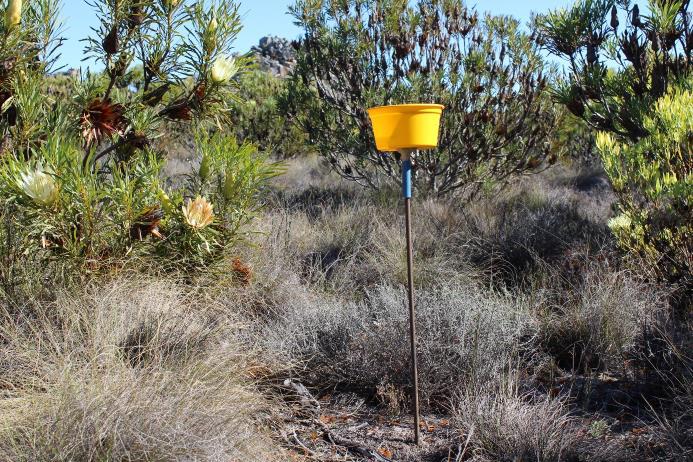Adedoja Opeyemi Adebayo
Ecological interactions are important drivers of the functionality of ecosystems. Most of these interactions such as the plant-pollinator interactions require species to interact at different trophic levels and result in enhanced productivity in both natural and agricultural ecosystems. The timing and success of this interaction are however dependent on climatic factors. Assessing how different plants and insect pollinators respond to climate change will be of global importance as conservation of plant-pollinator interactions enhances pollination services and thus safe guard the future of global food security. The study seeks to understand how change in temperature and other environmental variables across gradient of elevation affect insect-flower interaction in the Cape Floristic Region of South Africa where there is a high concentration of endemic plant and pollinator species and also one of the rich biodiversity hotspots in the world.

Elevated Pan trap for collection of visiting insects.
The functionality of ecosystem services are important in the conservation of biodiversity and natural resources. Climate change which is a major driver of global change has the potential to increase the rate and magnitude of the biodiversity extinction crisis across different regions of the world in the future (Beaumont et al., 2011). Reports have shown how climate change is affecting biodiversity and biomes around the world (Bellard et al., 2012; Parmesan, 2006). Some known effects include species range shifts, population decline, and even local extinction in some ecosystems (Root et al., 2003). This often results in a shift in the distribution and phenology of flowering plants and associated pollinators (Bartomeus et al., 2011). The effect of this has been reported mostly in the temperate region of the world (Benadi et al., 2014). However, less is known on how this affects speciation and diversity of non-crop natural plants as well as the visiting pollinators especially in the CFR with great plant endemism.
In this study, change in temperature will be modelled across gradient of elevation of a sentinel mountain and the effect of this will be observed on insect-flower interaction network. Sampling will be conducted during the spring period (August – October, 2017 and 2018). The mountain has an elevation of about 1600m and is home to important fynbos species. Study sites will be established at varying elevation of the mountain according to the profiles from the botanical survey by Agenbag et al., 2008. Two study sites will be established at 545m (Karro), 690-744 (Ecotone), 953-1303 (Mid elevation Sand stone fynbos) and 1576 (High elevation sand stone dwarf fynbos). Interaction will be recorded when an insect makes contact with the reproductive part of the flower. Insect observed will be recorded and identified. Where identification is difficult in the field, insects will be caught for later identification. Flower abundance and plant species richness will be done in 2mx2m plot. Also a measure of size of floral display will be determined following the approach of Vrdoljak, Samways and Simaika (2016). Microclimatic variables such as temperature, humidity, wind speed, will be recorded through the period of sampling. The composition, richness and abundance of pollinators will be assessed through the use of pan traps. Twelve yellow bowls will be used on each established sites. The bowls will be half filled with water and liquid detergent. Insects will be collected from these bowls after 24 hours.